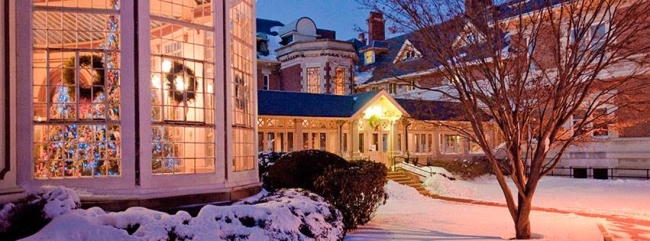You have /5 articles left.
Sign up for a free account or log in.

Dowling College
When Albert Inserra, the seventh president that Dowling College has had in the past 10 years, asked faculty this fall to redo their union contract and consider taking buyouts, his message was simple.
“If we don’t get this done,” he recalled saying, “I’m not sure we can make it.”
Dowling, with a beautiful campus on Long Island that once belonged to the Vanderbilts, is a poster child for the nation’s struggling private colleges.
Its enrollment has plummeted, and because nearly every penny Dowling has comes from current students, its finances are as precarious as those of perhaps any college in the country.
This fall, Inserra became the college’s latest president. In doing so, he had to ask professors to reopen a contract he negotiated for them in 2012 when he was a professor and the faculty union’s chief negotiator.
Through a combination of buyouts and layoffs, his new administration eliminated 26 faculty jobs, leaving the college with about 51 full-time faculty to teach its 2,000 students.
The college may have to hire recently released faculty back as adjuncts to teach spring classes. Besides its few dozen faculty, it’s also employed about 300 adjuncts.
The savings from the 14 buyouts and 12 layoffs and other cuts, Inserra said, are enough to keep the college going through next fall. After that, the future depends largely on how many students enroll. “We’re opening next year, now we need to open at the right number,” he said in a telephone interview this week.
Some of Dowling’s basic problems are typical for non-elite private colleges – enrollment shortfalls have driven budget shortfalls and layoffs across the country – but the consequences for Dowling have been especially dire.
Dowling is a mix of mostly undergraduate and professional students, with notable teacher education and flight training programs.
Some of Dowling’s problems, though, are unusual: the high presidential turnover, for one. Of its seven presidents in the past decade, including Inserra, three were intended to be temporary and three others were meant to be permanent, but all served only a short time. “We lost a tremendous amount of energy in that time frame and that change in leadership,” Inserra said.
At one point, a Board of Trustees chairman stepped into the role of acting president. The chairman, Scott Rudolph, is a successful businessman – he sells nutritional supplements – and was apparently trying to help the college in a pinch. He is a major donor and the main campus was named in his honor in 2000.
Yet, to the consternation of some faculty, he was perhaps the only college president in America who had not graduated college. He attended Dowling over four years in the late 1970s and had 69 credits from the college. In 2002, he was awarded an honorary degree from Dowling.
About a week ago, Rudolph left the Board of Trustees, of which he has long been a member. He did not respond to a request for comment.
Overall membership on the board, which is often the source of major donors for a college, has declined from 27 a generation ago to 10 following Rudolph’s recent departure.
The college’s finances have not been helped by the presidential turnover, which may have stalled attempts to raise money because few presidents were around long enough to establish relationships with donors. The last president, for instance, compiled a book of alumni, but may not have had time to woo them, since he served only about a year.
At other times, the college has been paying legal bills, settlements or compensation to presidents who didn’t serve as long as intended. Recently, it agreed to pay more than $400,000 to one former president, Robert Gaffney, who served from October 2006 to early summer 2010, according to Newsday.
Gaffney, who did not respond to a request for comment, sued the college for failing or refusing to pay him money still due even after he left the college. In turn, the board accused him in a legal filing of making poor decisions without the board's approval.
At one point, though, Gaffney was asking tough questions of the board that suggest deeper management problems in the college's recent history. In April 2010, for instance, Gaffney sent an email to board members expressing “grave concerns” about the operation and legality of the college’s distance education arm, the Dowling Institute. An internal document prepared around the same time said the institute might have been operating outside the law in several states, including New York. The current administration was not immediately able to comment on the status of the program, but Inserra said he was not aware of any current problems.
Outside observers have several times noted Dowling’s precarious position but praised Dowling’s then-new presidents for being the man to turn it around. Each time, the would-be savoir president left and the problems came back or remained unresolved.
At one point, Moody’s Investors Service noted that an incoming president was a positive sign for the institution's finances. That was Jeremy Brown, who took office in summer 2011. Just over a year later, Brown was gone. Last year, he became president of Portland Community College. He did not respond to an interview request left with his spokesman.
This summer, Dowling’s accreditor, the Middle States Commission on Higher Education, cited Dowling for several issues, including its finances, but praised then-President Norman Smith’s “experienced and effective leadership” and his new strategic plan. Within months of the accreditation report, Smith left the college. Inserra is now working to revise the college’s mission. Inserra said he's met with state officials concerned about the college and those meetings have reassured them about the track he plans to take.
The doings of the Board of Trustees have also drawn attention. Over the years, companies with ties to its trustees have done several million dollars’ worth of business with the college.
That’s changed, Dowling’s two most recent presidents – Smith and Inserra – said in interviews. “There’s no business going on between the board members and the college now,” Inserra said.
Inserra said the board is also bringing in new blood. Three people are waiting to be vetted for spots on the board.
The college's top financial officer is facing felony charges for a high-profile drunk driving incident that involved a Dowling party and a Dowling car. Police said the college’s current vice president of finance, Ralph Cuerello, drove at high speed the wrong way on a highway after attending a college holiday party.
A trial has not yet taken place, though Cerullo pled not guilty. A spokesman for the Suffolk County, New York, prosecutor’s office did not respond to a request for comment about why the case, from December 2010, had not yet gone to trial.
The past two presidents – Inserra and Norman Smith – both said they had not disciplined Cerullo because he had not been found guilty of a crime. Some faculty, privately, have called the situation an embarrassment.
“I very much believe in innocent until proven guilty,” Smith said. “He did not have a historic record; it was a one-time accusation.”
Inserra said the board has recently praised Cerullo’s work. Given the high turnover in other senior positions, Cerullo is also one of the college's longer-serving administrators.
Beyond the curious details, Dowling’s story, at its heart, is similar to those of other struggling private colleges.
Inserra said that Dowling's enrollment has declined from a peak of 5,700 in 2009 to about 2,000 this fall. A sudden drop in demand for teachers on Long Island delivered perhaps the sharpest blow to the college, according to current and former administrators and faculty.
Middles States’ report agrees, and blames the enrollment decline on external factors. At Dowling, students are a vital source of cash: 96 percent of the college's revenue came from tuition or other student sources in the 2013 budget year, according to Standard & Poor’s Ratings Services. The college’s endowment is about $2 million, down from $11 million a decade ago.
The team from Middle States also questioned Dowling's management, saying that until Smith arrived, the college was constantly in “crisis mode.”
Smith, now president of Suffolk University in Boston, considers the accreditation study a win. He was hired by Dowling through the Registry for College and University Presidents – a sort of executive temp agency for college administrators – five months before Middle States’ team came to visit. Smith, who said he has led Middle States studies of other institutions, said he moved quickly when he arrived to prepare for Middle States’ visit to Dowling.
In the end, the report found the college deficient on three factors, but praised Smith’s direction.
Smith said he left Dowling as soon as he could find someone capable of replacing him because the college would save “hundreds of thousands of dollars” by hiring a less expensive president.
Dowling’s bonds, floated through a local development agency, are considered junk by Moody’s Investors Service and Standard and Poor’s, two of the major credit rating agencies.
Of the colleges that Moody’s analysts rate, Dowling has the lowest rating. This spring, Moody’s downgraded the college, citing a “higher probability of default.” Two months ago, Standard & Poor’s, said the college had been unable to stabilize enrollment and had “transitional risks” associated with high turnover among administrators.
Eva Bogaty, a Moody’s vice president who assisted with the Dowling rating, said in a recent interview that it is a challenge for any college to grow while making cuts.
“With a small college like this, they tend to have a lot of fixed costs,” she said. “In that, we are seeing further pressure down the line... how far can you cut expenses while also trying to rebuild your enrollment is a particular challenge.”
Inserra said he hopes he can rebuild the college.
In a recent letter to parents, he was upbeat. He said he was “personally quite encouraged and excited about our school’s future.” He praised the “selfless action” by faculty to modify their collective bargaining agreement to save the college millions of dollars. (Several faculty members did not return calls or emails seeking comment.)
In an interview, Inserra talked about working to grow enrollment, and said an open house this year had more people than last. He also said the college has stepped up its social media outreach to students.
“My focus is on tomorrow and the growth... whatever happened in the past, this is what I have, and this is where I’m starting from, and this is what I’m planning to build,” he said.
Smith, the former president, said articles like this one are part of Dowling’s problems.
“Rumors of its death have been greatly exaggerated — and I think that’s probably its biggest public problem,” he said in a telephone interview.
He also cited at least one internal misstep as contributing to the college's current problems.
Dowling has been operating two campuses about 20 miles apart on Long Island. The second campus is a 60-acre space known as Brookhaven. Smith said the land looked like a deal: the college got it for $1. But it may not have been worth the price. Dowling began developing the property in earnest in 2002, with nearly $11 million in borrowed money. The second campus houses an aviation program and sports facilities, but never really became a success.
In summer 2013, the college closed a dorm that was less than 30 percent occupied.
During his time at the college, Smith advocated consolidating the campus, an effort Middle States praised. He said a college with as few students as Dowling cannot cost-effectively operate two campuses at that distance. The college was shuttling students back and forth on buses. At the same time, debt from developing the second campus is part of what is swamping the college, Smith said.
If Dowling had not acquired Brookhaven, Smith said, the college would not have the debt that would be downgraded, so Dowling wouldn’t be getting the resultant bad press.
Dowling's credit rating has attracted a lot of attention. In part, that's because credit ratings are an easy way to find get financial information on private nonprofit colleges that would not otherwise be available.
At Dowling, the annual operating budget for the college and the debt load are now about the same.
“Any college that has a debt larger than its annual operating budget has too much debt,” Smith said.
Inserra, who calmly waded through the college’s checkered recent history in an hourlong telephone interview, said he’s working to shore up the place; at the very least, he said, the recent union concessions will allow the college to open its doors next fall.
He said his actions – not his words – will provide the clearest guide to Dowling’s future.
“What I say doesn’t really matter that much; it’s what I do and whether we reach the goals we have to reach,” Inserra said.








